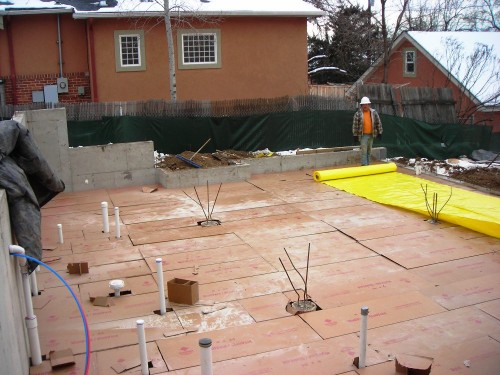
When a new house is located on a site with expansive soil an elevated structural floor is typically the best solution to prevent unwanted floor movement in the basement.
The normal slab-on-grade basement floor is 4″ thick and is supported by the soil. If the soil moves, the basement floor will move. You can learn move about how to build walls on a slab-on-grade basement floor at this previous post Why It’s Critical To Have Correct Floating Sill Plates on Slab-On-Grade Floors in Colorado
There are several different types of elevated structural floors used.
The first type of floor was a wood floor that typically matched the same joists and beams as the main floor, just built 8ft to 10ft below the main floor and hung onto wood ledgers around the perimeter of the foundation. The wood floor would perform the same as the main floor. Unfortunately, a wood floor requires at least 18″ of clearance between the lowest part of the wood floor and the soil. The condition of the crawlspace below the wood floor is critical since mold can easily become a problem. In addition, many floors became wavy over time as the basement walls pushed in on the weaker wood diaphragm that was needed to brace the foundation walls.
When wood floors became a concern due to that M-word “mold”, steel and concrete were introduced.
Steel beams, steel corrugated decks and 3″ to 4″ concrete topping soon became the standard for an elevated structural floor. This is a great floor system and performs very well. It has the required high strength concrete floor diaphragm to brace the basement walls and won’t promote mold growth. The floor is built using the main beam line that typically matches the main floor beams. Then steel beams are spaced at 5ft to 6ft o.c. to support the steel deck. A concrete topping is then poured on the metal deck. One issues I run into with steel floors is the reduced crawlspace size. Now that a 18″ clearance isn’t required and no access to any mechanical systems is below the basement floor, the builders typically provide a clearance between the bottom of the steel beams and soil the same as the void space specified in the geotechnical report, typical 6″ to 8″. The 8″ of clearance makes it very difficult to move around below the floor if needed for inspection, repairs, new plumbing or any other reason. The small space is also difficult to ventilate. I highly recommend you talk to your builder about the amount of space that will be provided below the elevated structural floor.
There is another elevated floor system that avoids mold, has no crawlspace and reduces excavation costs, a two-way concrete floor. This floor system is a 6 1/2″ minimum thick concrete floor reinforced to span up to roughly 15ft. The concrete floor is supported by the foundation walls by the use of reinforcement and then interior piers. During construction, the concrete is elevated by using cardboard forms. A builder can use 100% cardboard forms or rows of cardboard forms that support a metal or Styrofoam deck. With higher demands for better insulation an elevated two-way concrete floor will also allow for a Styrofoam deck that will help insulate the floor. This elevated floor system will feel and look the same as a typical slab-on-grade.
For all floor systems near or on grade a sealed vapor retarder is always recommended. This will help reduce moisture entering the crawlspace or floor system.








1 thought on “Basement Structural Floors”
Pingback: Raising House – DIY Network — EVstudio, Architect Engineer Denver Evergreen Colorado, Central Texas Architect
Comments are closed.